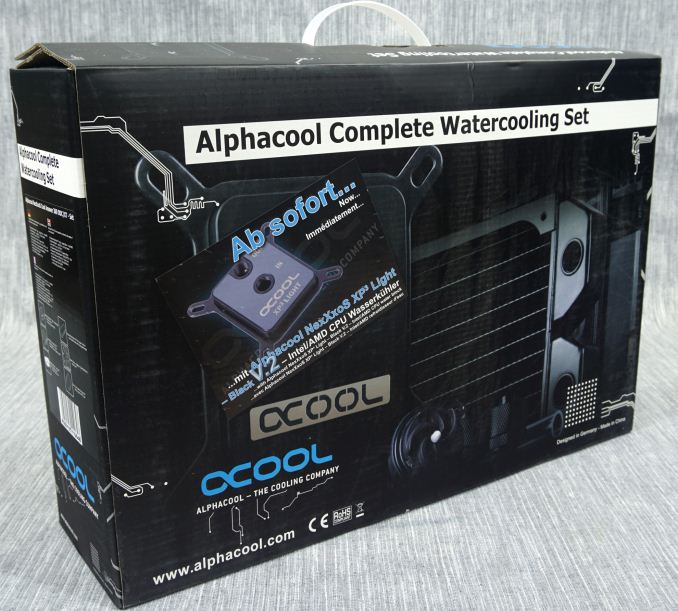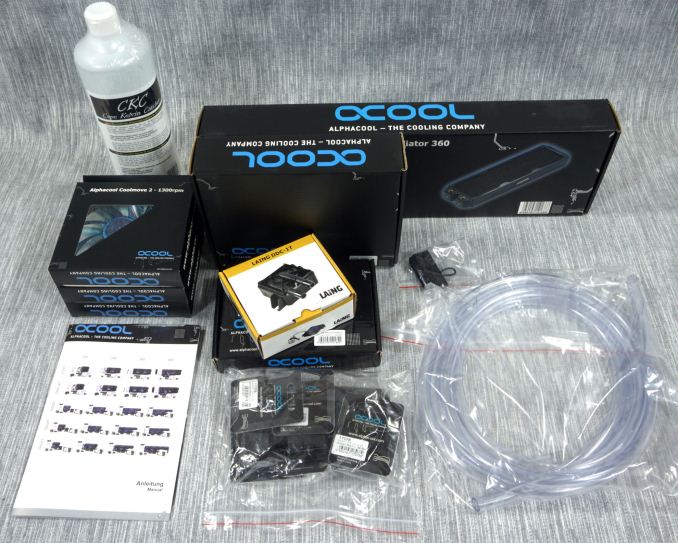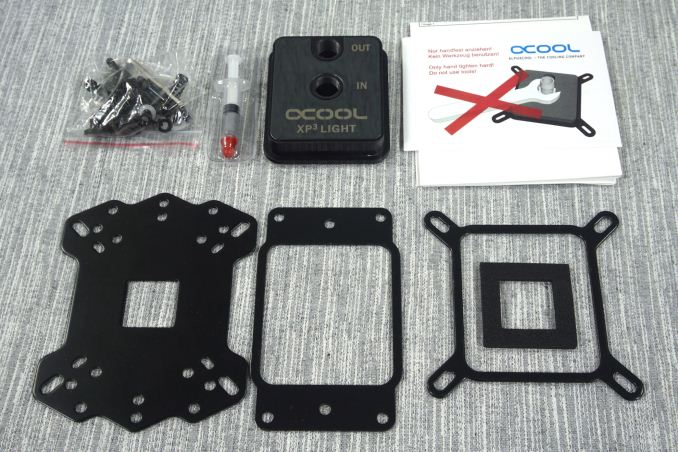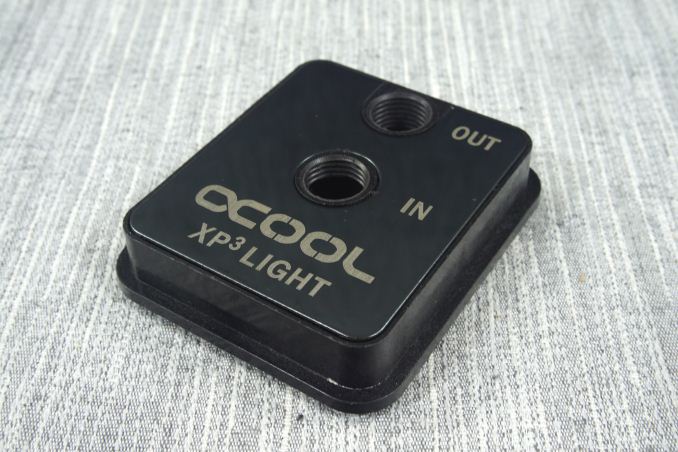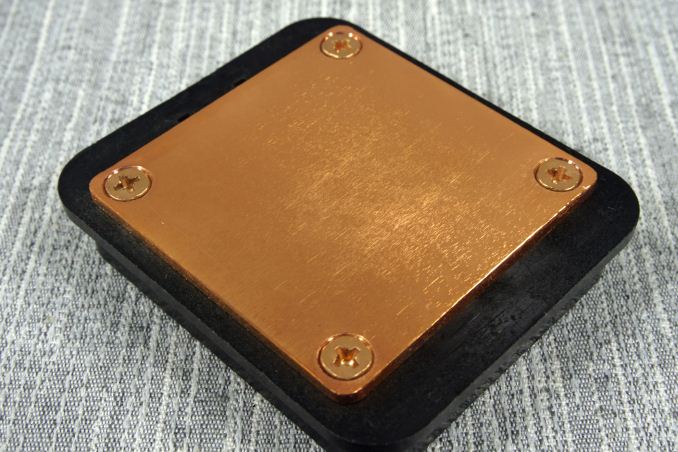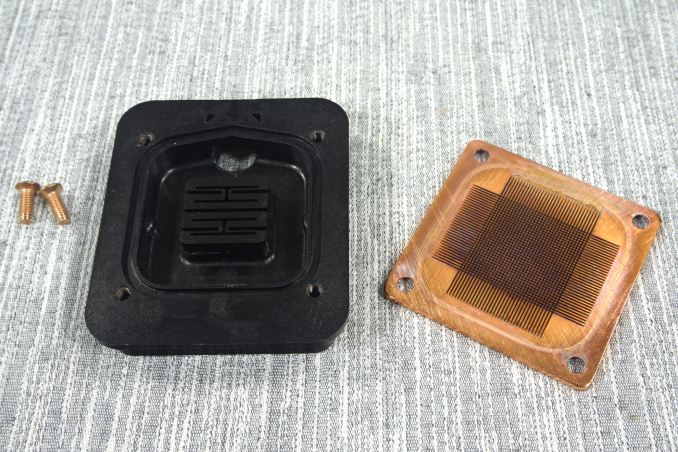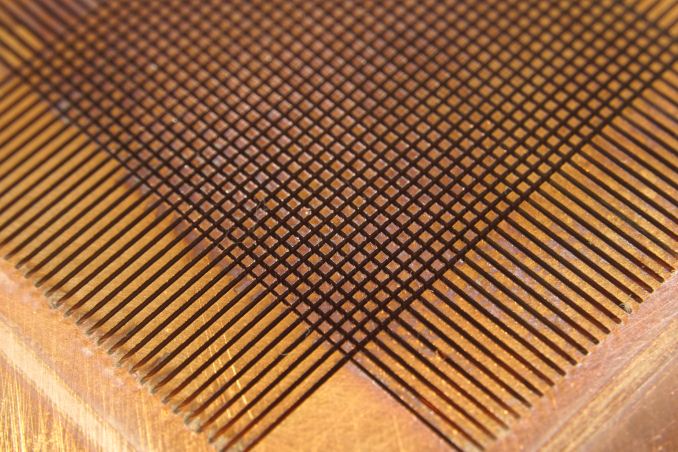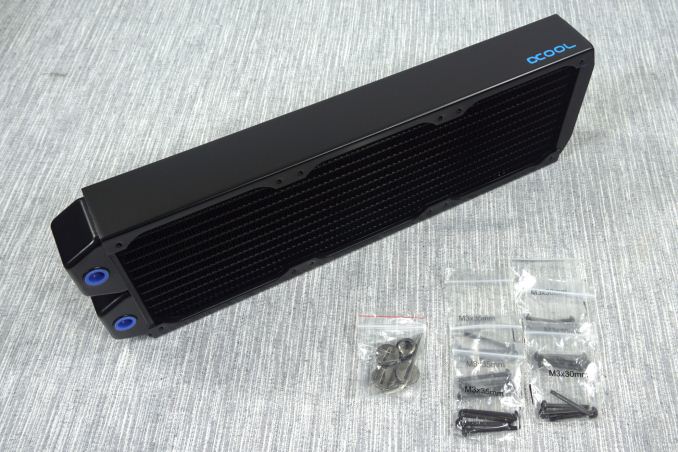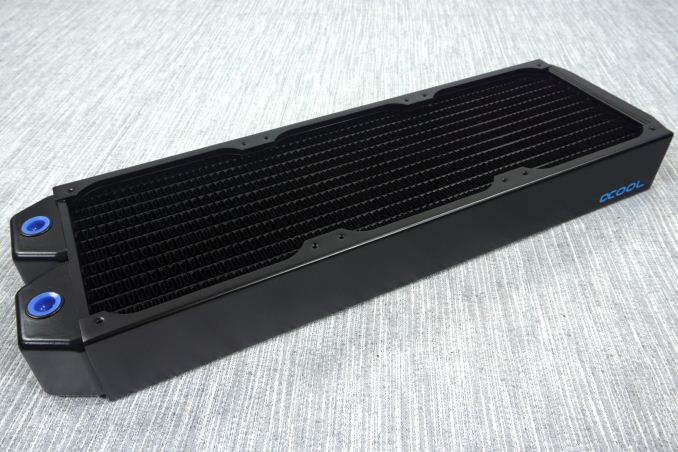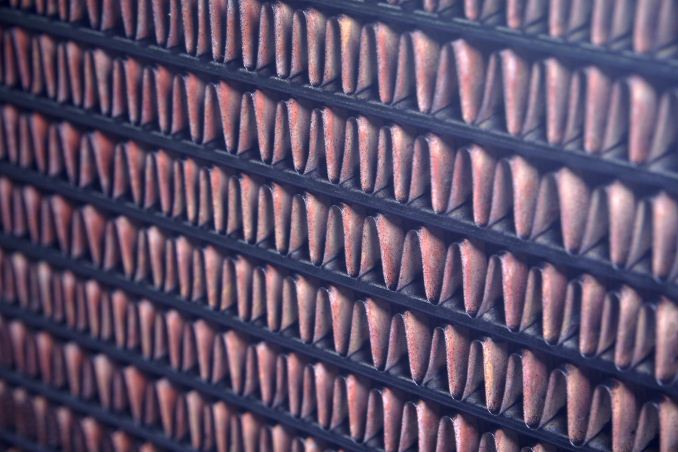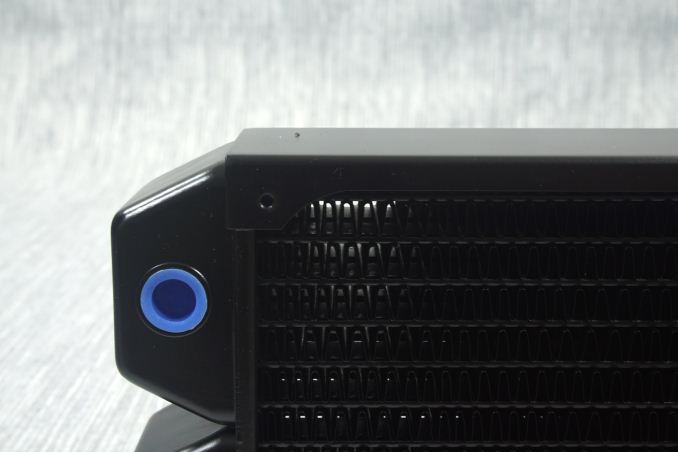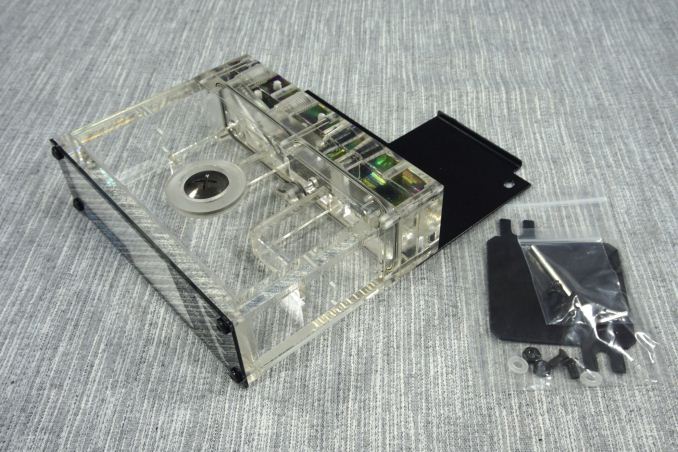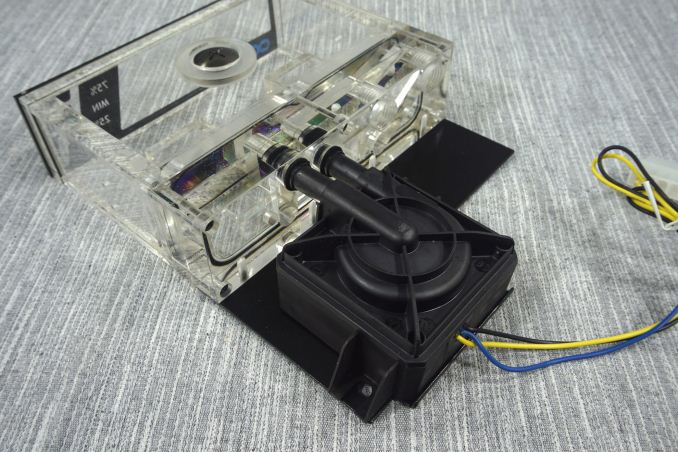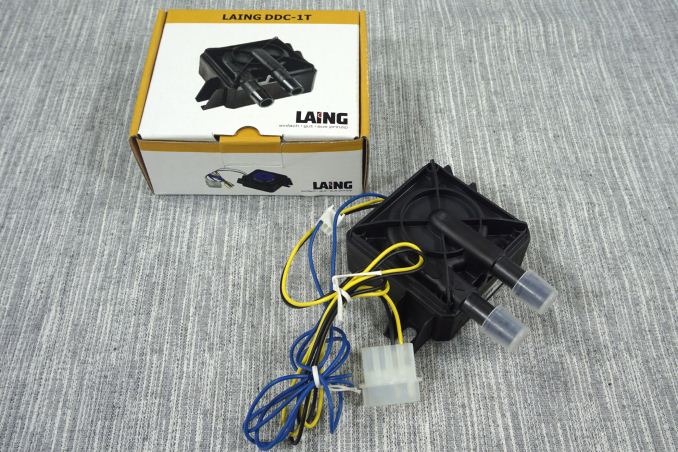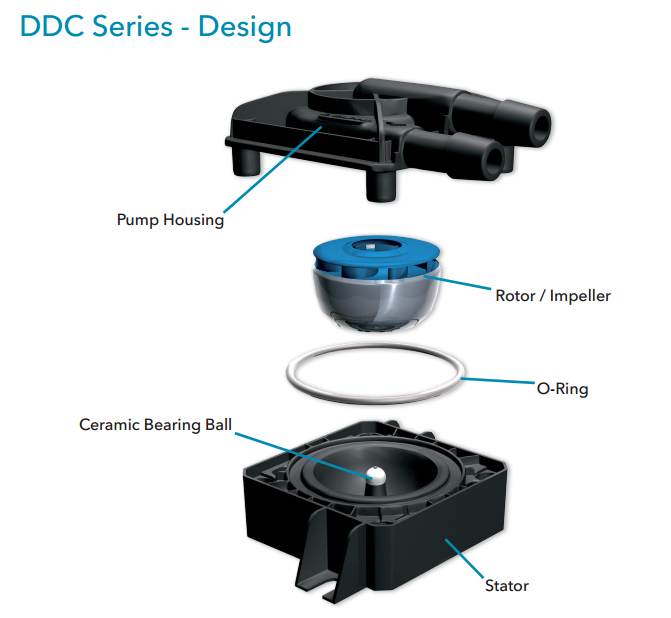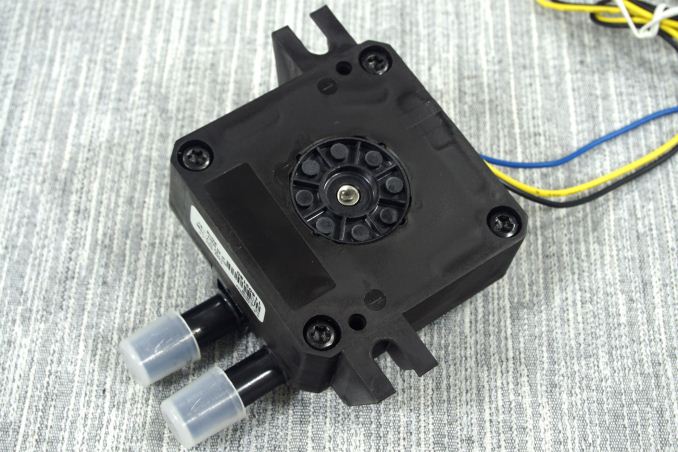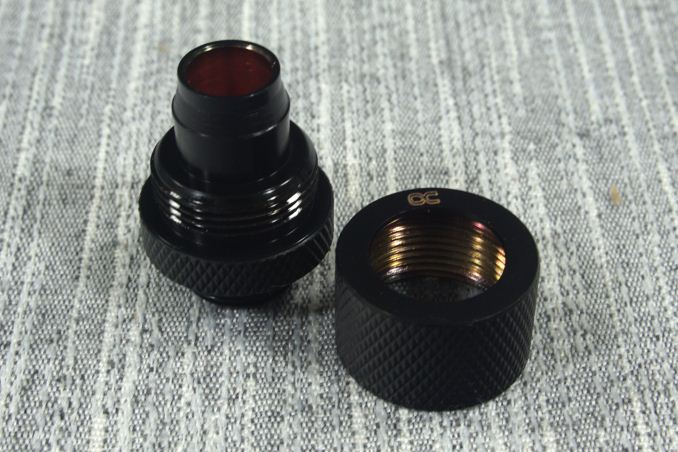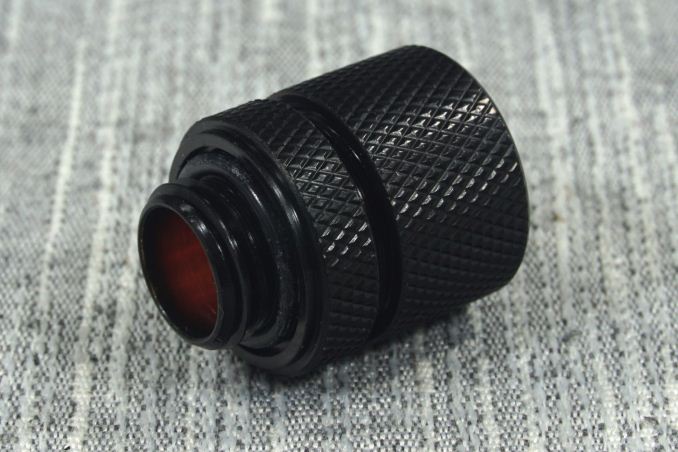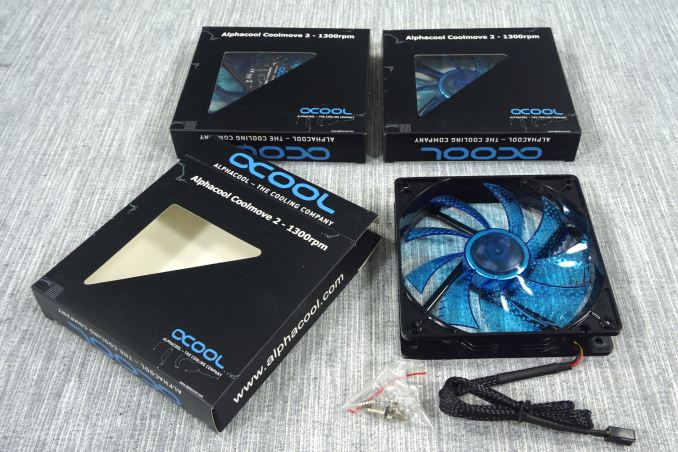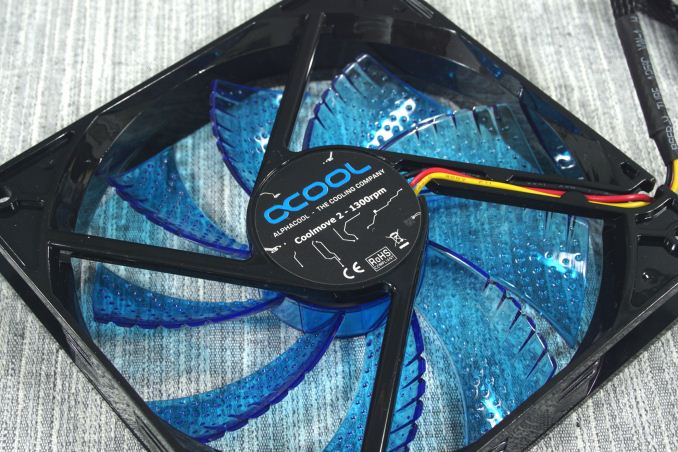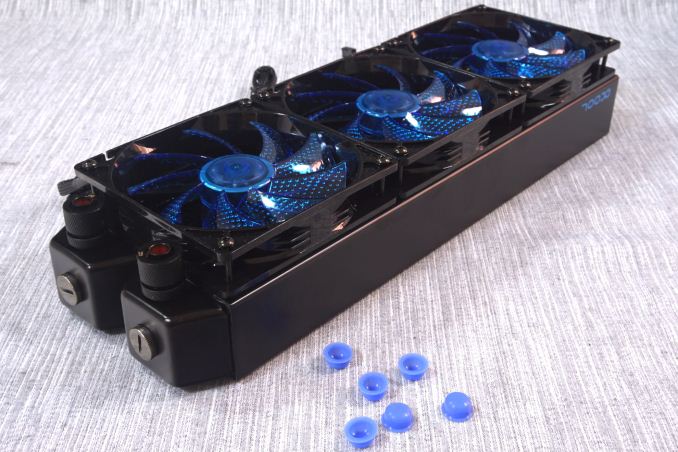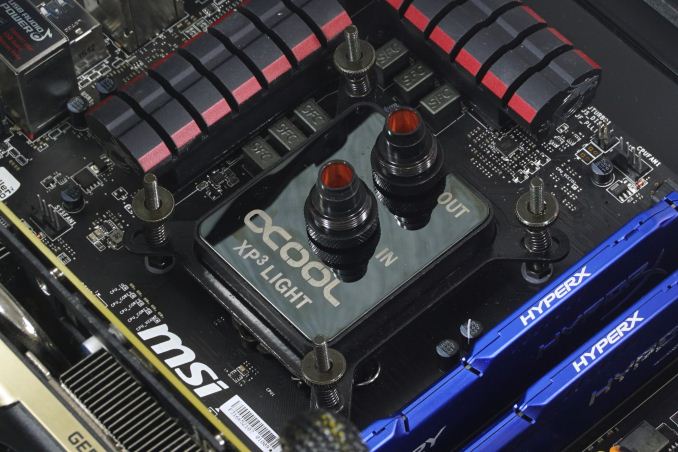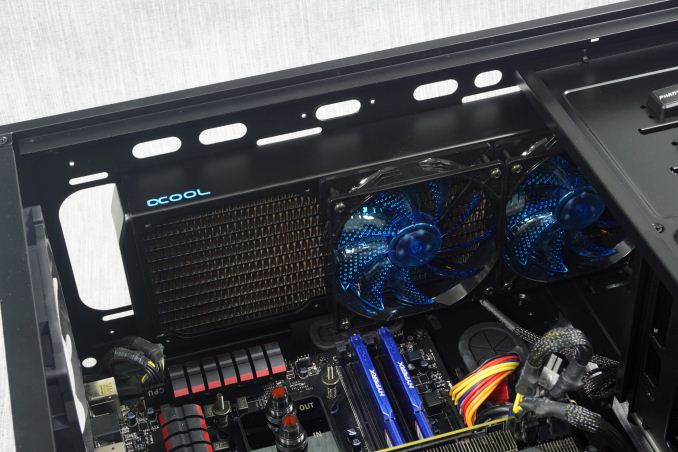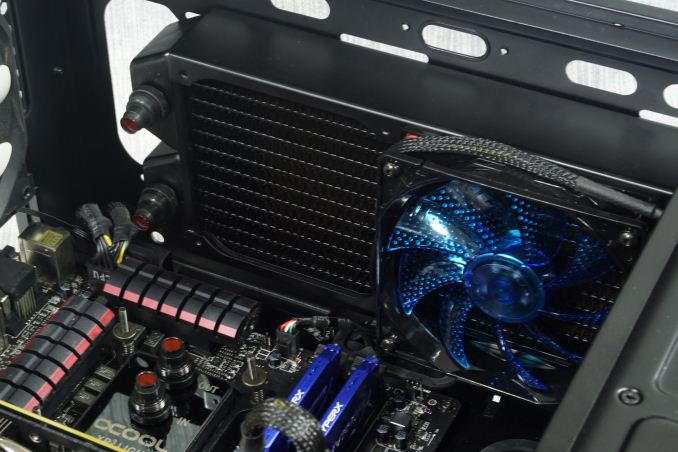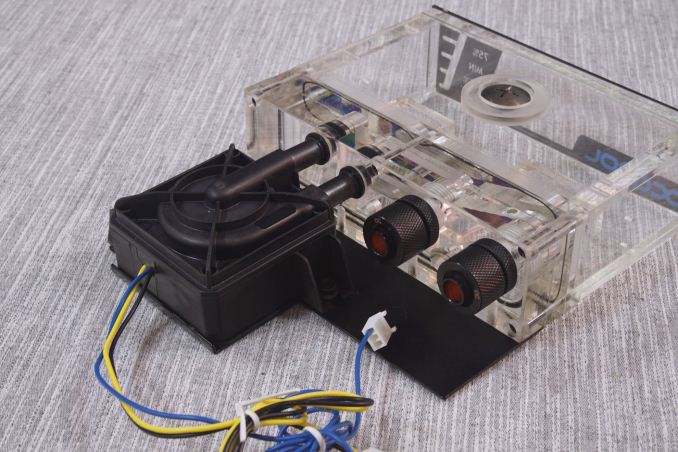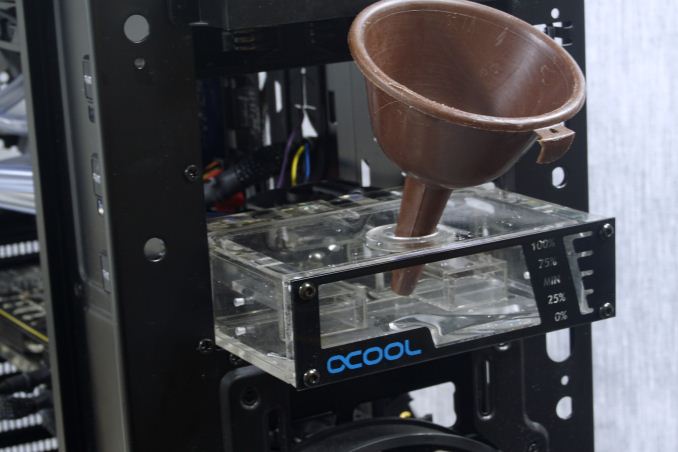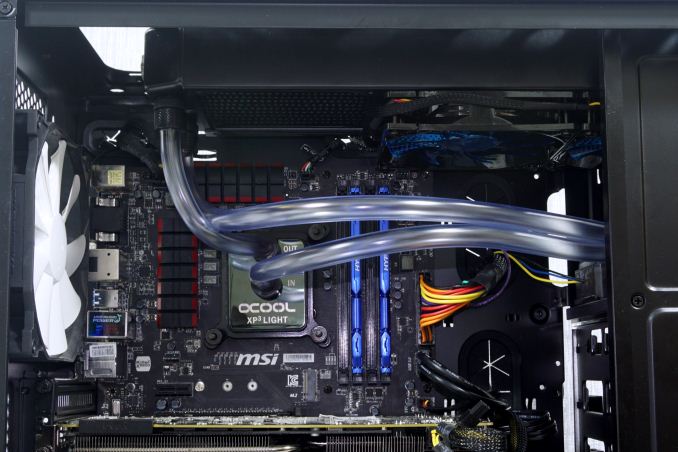
Not so long ago, PC liquid cooling was considered to be an extreme approach, one performed by hardcore enthusiasts and overclockers alone. There were no commercial products available and every individual system was designed by the user. Radiators were modified heater cores extracted from cars, CPU blocks were rare and occasionally machined at local workshops using a copper block and a mill, while high-performance tubing came from shops with medical supplies.
As demand grew, aided by the ever-increasing noise of small CPU heatsinks, companies specializing in these “open loop” liquid cooling solutions began turning up — a little too fast perhaps, as tens of companies were founded within a few months’ time and very few of them actually survived for more than a couple of years. Enthusiasts could then buy specialized liquid cooling equipment and even whole kits from just one seller and only had to assemble the setup into their system. That of course is no simple process for an amateur and a nightmare for a system builder, who had to find ways to ship systems pre-filled with coolant or assume that the user has the skills required to fill & maintain such a system. The payoff in terms of cooling was often immense, but the potential market remained limited to advanced users only.
Liquid coolers finally achieved adoption with the wider enthusiast use base at the start of this decade, when the likes of Asetek and CoolIT Systems came up with an inexpensive closed loop solutions, a design was just as simple to install as a common air cooler and required virtually no maintenance at all. However, as convenient as these all-in-one (AIO) solutions may be, hardcore enthusiasts find them lacking and inflexible. Some of the compact AIO designs can hardly compete against air-based solutions in terms of performance. A few companies began making their systems expandable, but the main parts of the system still cannot be upgraded. As such, AIO coolers rarely are acceptable solutions for the most hardcore of enthusiasts and overclockers, who need the best performance and still prefer designing and building their own liquid cooling systems.
Alphacool is a German designer and manufacturer of liquid cooling systems for PCs who has also diversified into producing liquid cooling systems for industrial and medical applications. They are one of the oldest companies in the field and, even though we did have a review of their recent Eisbaer AIO solutions, their specialization lies with the design, manufacturing and supply of high performance liquid cooling parts for advanced PCs.
Except from individual parts, Alphacool also supplies their products as complete pre-tested kits. It is one of these kits that we will be reviewing today, the NexXxoS Cool Answer 360 DDC/XT. The kit includes:
- 1x Alphacool NexXxoS XP3 Light Cooling Block
- 1x Alphacool Repack 5,25 Bay Reservoir
- 1x Laing 12V DDC-1T Pump
- 1x Alphacool NexXxoS XT45 Full Copper Radiator
- 3 meters AlphaTube tubing HF 13/10 (3/8“ID) – clear
- 6x Alphacool HF 13/10 Compression Fittings G1/4
- 3x 120 mm Alphacool Coolmove Fans
- 1x Alphacool CKC Cape Kelvin Catcher Liquid 1000ml
- 1x ATX-bridging plug (24 Pin) – black
Alphacool supplies the NexXxoS Cool Answer 360 DDC/XT kit in a large, very sturdy cardboard box. The artwork is simple, based on pictures of the included parts and basic information about the kit.
Every included part is packed in its own cardboard box, meaning that the exterior box only provides shipping convenience and protection. The packaging of the individual parts, with the exception of the liquid pump, bears the Alphacool company logo. The clear PVC tubing does not have its own packaging, though that would be redundant as it is nearly impossible to damage such an item during transport. Alphacool also supplies a thorough manual.
Except from the block itself, the necessary hardware for the mounting of the block – including a universal backplate and retention brackets for Intel and AMD platforms – can be found inside the packaging of the block. There is also a small syringe with unbranded silver thermal material and instruction manuals.
Alphacool has designed the NexXxoS XP3 Light to be compact and easily adaptable for future platforms. It is very small and lightweight, hardly larger than the CPU socket itself. Two openings for the compression fittings can be seen at the top of the block. The user has to make sure that the flow goes in from the center of the block and out from the edge, otherwise there will be a great loss of performance. Alphacool also includes a very clear notice that no tools should be used for the tightening of the compression fittings, as that can easily damage the plastic threads. Tightening the compression fittings by hand is more than enough.
The base of the NexXxoS XP3 Light is obviously copper. It is well-machined and smooth enough, but Alphacool did not bother polishing it down to a mirror finish. The company likely expects that the experts who would buy such a kit already know that a perfect mirror finish would not actually benefit performance by a measurable amount. Alphacool is also using copper screws in order to prevent chemical oxidation.
The interior of the NexXxoS XP3 Light is relatively simple, yet it is more complex than what an untrained eye might realize. The plastic part forms two H shaped jets that forcefully direct liquid flow towards the copper base. The copper base is practically a thin sheet of copper that has many small traces engraved into it, forming about a thousand mini rectangular pylons. The pressure generated by the jets forces the liquid to move in-between these mini pylons, enhancing heat transfer.
Perhaps the most important part of the system is the massive NexXxoS XT45 radiator. Alphacool supplies it along with mounting and fan screws, as well as with four plugs.
The 360 mm-class XT45 is a massive heat exchanger that measures 400 mm long and 46 mm thick. Its exterior frame is steel, while the chambers and the fins are copper, resulting to a massive weight of 1.4 kg without any parts/fans attached. The paint job of the steel frame is excellent, but it is only superficial on the radiator itself, covering just a bit of the copper chambers. Close inspection reveals that the fins are bare copper.
Alphacool placed not two but six openings for compression fittings, which is why they also supply four plugs alongside with the radiator. The user can select two of the fittings with the most suitable orientation, or even connect more than one loop/system to a single radiator.
The Alphacool Repack is a reservoir designed to fit into a 5.25” external drive bay. This kit includes the DDC version of the reservoir that is designed to be joined with a Laing DDC pump. Although this particular version cannot be used with any other kind of pump, Alphacool offers several versions of this reservoir, including a simple version with compression fittings only.
The Repack is made almost entirely out of clear acrylic. The acrylic is very thick and inflexible, giving the reservoir exceptional overall mechanical strength. Alphacool installs a black metallic plate at the front of the reservoir with their logo, mainly serving as a level meter, but it can be removed if the user wishes. A metallic support plate at the rear of the reservoir is used as a support for the pump.
Two round openings for the pump’s headers and two threaded openings for compression fittings can be seen at the rear of the Repack. Note that the reservoir has internal pathways that separate the incoming and outgoing flows. The left of the compression fittings leads directly to the output of the pump, while the right fitting is for the incoming flow that leads the liquid into the reservoir. Unfortunately, there is no decoupling method for the pump, as it gets attached directly onto the metallic support plate. This transfers all of the vibrations of the pump to the reservoir and, in extension, to the case. Depending on the materials and the quality of the case, this can increase the overall noise output of the system.
The Laing DDC-1T pump is not of Alphacool’s design. Rather the pump is a product of Goulds Water Technology, a Xylem brand, a company that specializes on commercial and industrial pumps. So that the pump could be used inside a PC, Alphacool merely attached a Molex power connector and a 3-pin tachometer sensor.
Although it looks like a very simple plastic apparatus, the DDC-1T is actually one of the best low-voltage DC pumps currently available. It utilizes a hemispherical motor that does not require shaft bearings and/or seals, significantly improving reliability and minimizing noise. The DDC-1T is also very powerful for a 10W device of this size with, according to Alphacool, a maximum discharge head of 3.7 meters and a maximum flow of 420 l/h. Goulds Water Technology states 4.5 m head and 410 l/h respectively in their specifications sheet.
The only downside of the DDC-1T is the narrow voltage operating range. This particular model can only operate with a voltage of 8V to 13.8V (12V maximum for a typical PC) and has a starting voltage of at least 9V, severely limiting its speed control capabilities. This is why Alphacool offers it with a Molex power connector; although your motherboard’s header should not have an issue powering the 10W pump, the company does not expect users to try and speed control it, as it can easily stall and stop if the supplied voltage drops under 8V, or not even start under certain situations.
Although the selection of proper fittings may seem like a mundane task, there are at least a few things that serious water cooling users need to be aware of. The first is the material of the fitting, as certain metals can cause serious corrosion even when using highly anti-corrosive liquid mixtures, and the second is the coloring (if present), as colors will fade very rapidly on certain materials like copper and brass.
Things get a little more complicated with compression fittings. Unlike simple barbed fittings, the compression fittings are made for tubing with a specific internal and outer diameter (ID and OD respectively). They are more convenient as this allow the user to tighten them by hand and offer more room for aesthetic interventions, but their nature requires precise machining with minimal tolerances. A poor quality compression fitting can easily become the source of leaks.
Alphacool’s HF fittings are made of brass and specifically for 13/10 mm OD/ID tubing. They are painted back with a chromating method that binds the color to the brass, preventing fading. The locking rings have a textured design for better grip. At nearly 6€ per piece, these are rather expensive, but the quality assurance is probably worth the high cost in a system that a poor quality item can cause catastrophic failures.
Alphacool also supplies three 120 mm fans with this kit. The fans have black glossy frames and semitransparent blue blades. The blades are not flat but have jagged edges and hemispherical engravings, giving it a golf ball appearance. Their cables are sleeved using typical nylon black sleeving.
The company has rebranded the fans, hiding the OEM from the public. According to their specifications, these fans has a maximum speed of 1300 RPM and Hydro-Dynamic Bearings. It seems strange that the company decided to include a nine-blade design in a kit with a radiator this thick; fans with fewer and wider blades would have better pressure and could achieve better performance, especially at lower RPM. Alphacool however states that the XT45 is optimized for low/medium speed fans, which explains their choice.
Casual users often wonder about how much harder the installation of a kit is over a AIO solution or even an air cooler. Actually, the installation itself is not very complex – the selection of the proper parts is. As the NexXxoS Cool Answer 360 DDC/XT is a full liquid cooling kit, it gives us the chance to demonstrate the installation process and highlight some of the most critical difficulties.
The first step is to install the liquid cooling block onto the CPU. Due to the size and the design of the block, this may be a very easy process, even easier than the installation of a simple air cooler. The Alphacool XP3 Light is a very easy to install block. Once the backplate with the support screws is attached to the rear of the motherboard, the block is simply fastened on the CPU using the thumbscrews and springs.
A critical issue when selecting liquid cooling parts is the selection of a proper radiator. A larger radiator will not necessarily improve performance, especially if the pump is weak and it can easily cause compatibility issues. In our case, we do have a powerful pump and the kit is configured with maximum performance and expandability in mind, so the XT45 radiator is a judicious choice.
It is however so thick that we could not fit it even in the Phantecs Enthoo Pro, a case specifically designed to support large radiators, just because the third fan was interfering with the extruding motherboard’s heatsinks. This might not have been an issue if we simply chose another motherboard with different heatsinks/layout. When selecting a high performance radiator, it is critical to take into account both the clearance of the case and the possible interference from other hardware parts.
The joined 5.25” bay reservoir and pump assembly does increase the ease of installation significantly. A stand-alone pump and reservoir would require the user to seek his/her own mounting space and methods. The placement of a reservoir in a 5.25” bay may seem very easy and straightforward, but there is a small catch; you cannot actually access the filling hole while the reservoir is inside the bay. As the reservoir needs to be pulled at least partially outside of the case, the user needs to make sure that the tubing is long enough to allow for it. For a fully clear reservoir, it is a pity that it does not have any lighting or direct support for external lighting options. This will not be an issue in a well-lit system though.
We should note that the Repack reservoir did not actually fit into the Enthoo Pro directly, as the body of the reservoir would not fit in between the side 5.25” device support tabs of the chassis. We had to bend two of the tabs out of the way in order for the reservoir to slide into a 5.25” bay. In order to effortlessly fit into any case, it should vertically have a slightly narrower body than its front faceplate, exactly like 5.25” devices do.
Once fully assembled, the liquid cooling setup looks very tidy and futuristic, having the system standing out from the appearance of a typical PC. When everything has been double-checked and tightened well (by hand, tools will damage most of these parts), it is time to fire up the PSU and fill the system with liquid. Note that the PSU needs to be disconnected from all of the system’s devices during this process, especially the motherboard. Alphacool provides a connector for the PSU that will start it without having to connect it to a motherboard, allowing to calmly fill the kit with liquid and check for leaks. Do not attempt to fill the kit with liquid by powering on the main system even if you are certain that there are no leaks because the CPU will overheat and risk damage in a matter of a few seconds without liquid into the loop.
Although the testing of a cooler appears to be a simple task, that could not be much further from the truth. Proper thermal testing cannot be performed with a cooler mounted on a single chip, for multiple reasons. Some of these reasons include the instability of the thermal load and the inability to fully control and or monitor it, as well as the inaccuracy of the chip-integrated sensors. It is also impossible to compare results taken on different chips, let alone entirely different systems, which is a great problem when testing computer coolers, as the hardware changes every several months. Finally, testing a cooler on a typical system prevents the tester from assessing the most vital characteristic of a cooler, its absolute thermal resistance.
The absolute thermal resistance defines the absolute performance of a heatsink by indicating the temperature rise per unit of power, in our case in degrees Celsius per Watt (°C/W). In layman’s terms, if the thermal resistance of a heatsink is known, the user can assess the highest possible temperature rise of a chip over ambient by simply multiplying the maximum thermal design power (TDP) rating of the chip with it. Extracting the absolute thermal resistance of a cooler however is no simple task, as the load has to be perfectly even, steady and variable, as the thermal resistance also varies depending on the magnitude of the thermal load. Therefore, even if it would be possible to assess the thermal resistance of a cooler while it is mounted on a working chip, it would not suffice, as a large change of the thermal load can yield much different results.

Appropriate thermal testing requires the creation of a proper testing station and the use of laboratory-grade equipment. Therefore, we created a thermal testing platform with a fully controllable thermal energy source that may be used to test any kind of cooler, regardless of its design and or compatibility. The thermal cartridge inside the core of our testing station can have its power adjusted between 60 W and 340 W, in 2 W increments (and it never throttles). Furthermore, monitoring and logging of the testing process via software minimizes the possibility of human errors during testing. A multifunction data acquisition module (DAQ) is responsible for the automatic or the manual control of the testing equipment, the acquisition of the ambient and the in-core temperatures via PT100 sensors, the logging of the test results and the mathematical extraction of performance figures.
Finally, as noise measurements are a bit tricky, their measurement is being performed only manually. Fans can have significant variations in speed from their rated values, thus their actual speed during the thermal testing is being acquired via a laser tachometer. The fans (and pumps, when applicable) are being powered via an adjustable, fanless desktop DC power supply and noise measurements are being taken 1 meter away from the cooler, in a straight line ahead from its fan engine. At this point we should also note that the Decibel scale is logarithmic, which means that roughly every 3 dB(A) the sound pressure doubles. Therefore, the difference of sound pressure between 30 dB(A) and 60 dB(A) is not “twice as much” but nearly a thousand times greater. The table below should help you cross-reference our test results with real-life situations.
The noise floor of our recording equipment is 30.2-30.4 dB(A), which represents a medium-sized room without any active noise sources. All of our acoustic testing takes place during night hours, minimizing the possibility of external disruptions.
| <35dB(A) | Virtually inaudible |
| 35-38dB(A) | Very quiet (whisper-slight humming) |
| 38-40dB(A) | Quiet (relatively comfortable – humming) |
| 40-44dB(A) | Normal (humming noise, above comfortable for a large % of users) |
| 44-47dB(A)* | Loud* (strong aerodynamic noise) |
| 47-50dB(A) | Very loud (strong whining noise) |
| 50-54dB(A) | Extremely loud (painfully distracting for the vast majority of users) |
| >54dB(A) | Intolerable for home/office use, special applications only. |
*noise levels above this are not suggested for daily use
The thermal performance of the NexXxoS Cool Answer 360 DDC/XT kit proves that size (and powerfulness) does matter. With its fans and pump at maximum speed, it wipes the floor with the AIO coolers that we have tested up to this date. Top-tier air coolers follow closely behind the AIO liquid coolers. Mainstream and stock air coolers are virtually incomparable against the NexXxoS Cool Answer 360 DDC/XT.
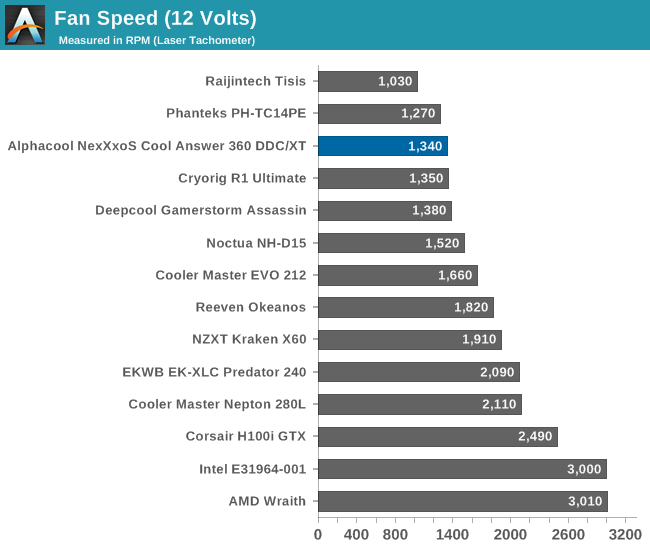
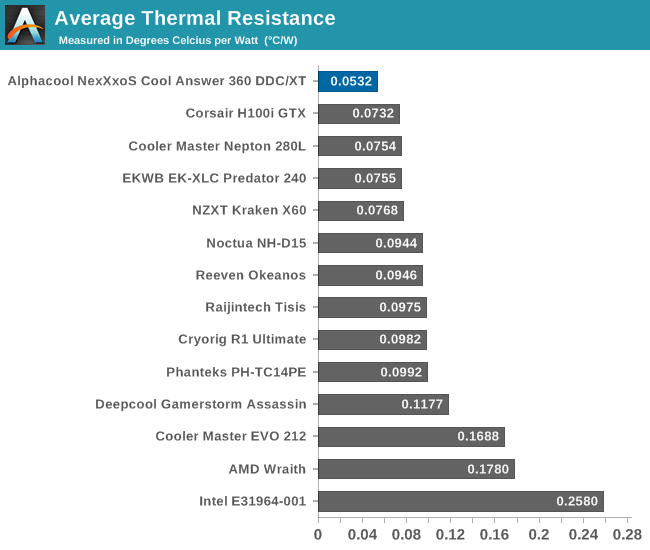
The average thermal resistance of the NexXxoS Cool Answer 360 DDC/XT is 0.0532 °C/W, the best that we have recorder to this date by any cooler, air or liquid based. It remains almost entirely constant regardless of the thermal load, hinting that the system is capable of both quick thermal energy absorption from the CPU and fast dissipation to the environment regardless of the thermal load. In other words, both the pump and the radiator are dramatically oversized for the cooling of a single CPU. The performance of this kit would most likely be only slightly affected, if affected at all, even if a couple of GPU cooling blocks are added to it.
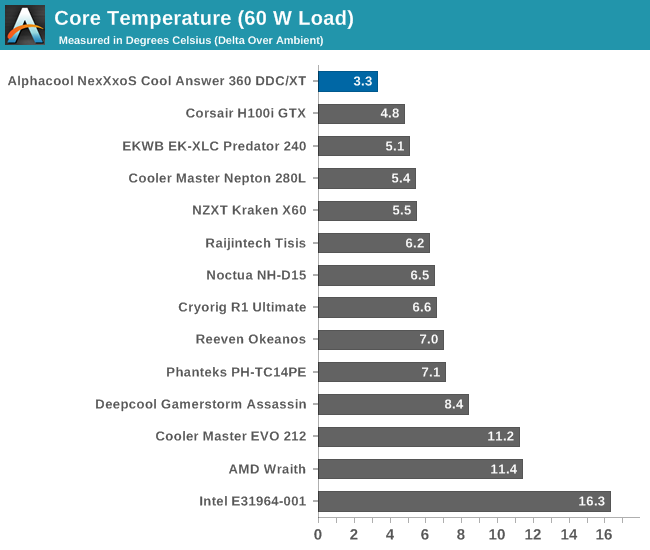
| Core Temperature, Constant Thermal Load (Max Fan Speed) |
With its fans at maximum speed, the NexXxoS Cool Answer 360 DDC/XT produces a sound pressure that measures 43.4 dB(A) from one meter away. This is significantly better than what most AIO coolers that we have tested to this date can achieve, but it would still be uncomfortably loud for the majority of home users and gamers.
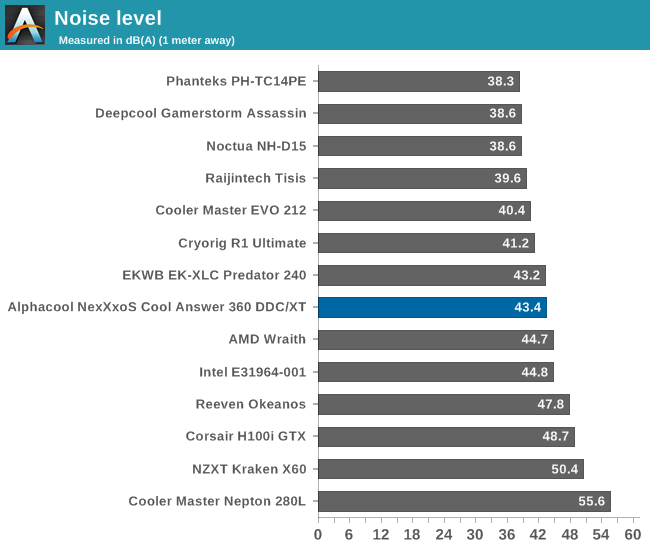
The performance of the NexXxoS Cool Answer 360 DDC/XT changes significantly when its fans have their speed reduced down to 740 RPM. Note that the pump cannot be controlled, at least not without modifications, therefore it is constantly operating at maximum speed during our testing. The NexXxoS Cool Answer 360 DDC/XT appears to be still leading most of the charts, with an average thermal resistance of 0.0826 °C/W. This figure however brings it very close to significantly smaller AIO coolers. Cooler Master’s Nepton 280L actually manages to surpass the NexXxoS Cool Answer 360 DDC/XT at higher thermal loads, but it makes use of much more powerful (and louder) fans.
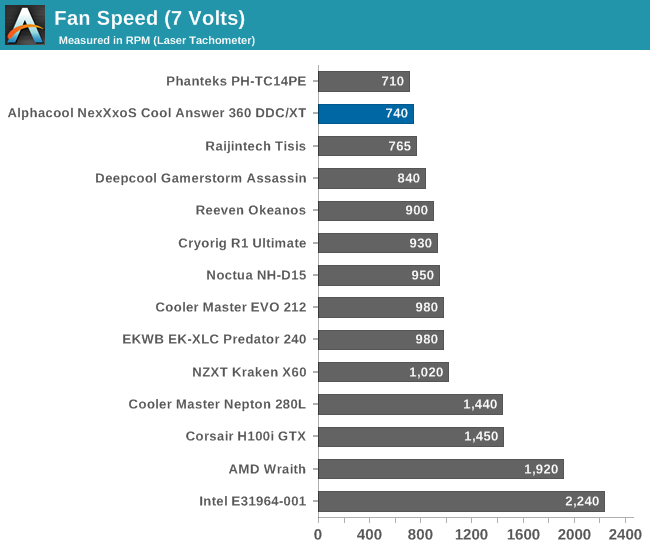
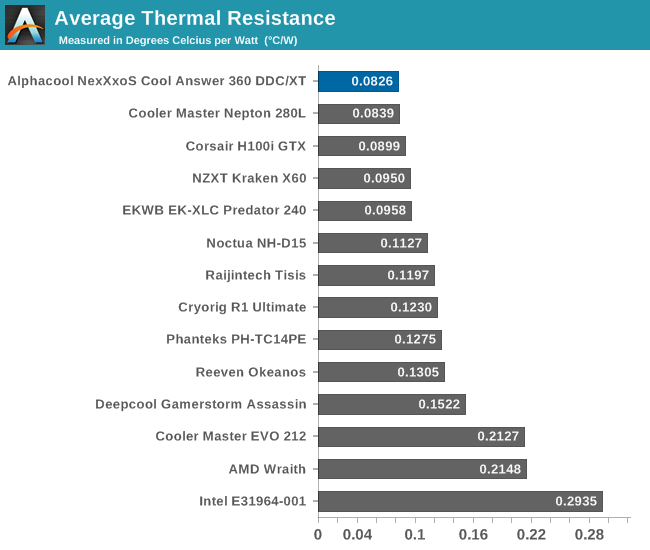
Considering that the pump’s flow remains exactly as powerful as before and is much superior than that of the small pumps that AIO solutions are using, it is clear that the significant loss of performance is due to the low pressure of the fans. High flow fans such as those that Alphacool supplies have their pressure dropping dramatically as their speed decreases. With a radiator as thick as the XT45, it is a miracle that the NexXxoS Cool Answer 360 DDC/XT can perform this well with these fans rotating at just 740 RPM each.
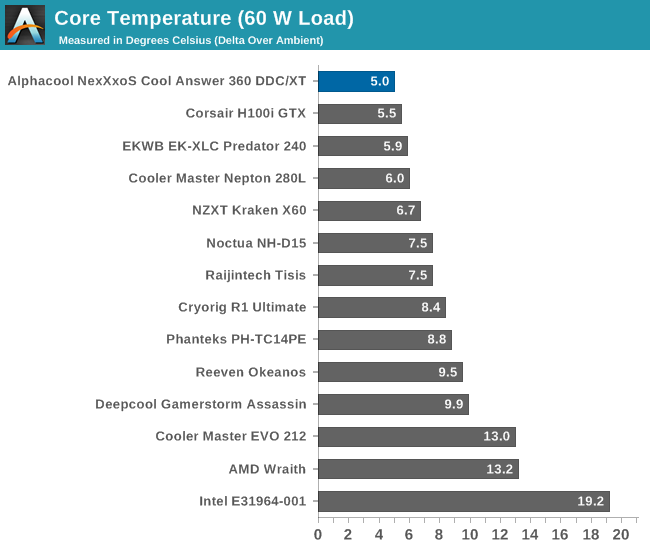
| Core Temperature, Constant Thermal Load (Low Fan Speed) |
The Coolmove 2 fans are completely silent at this speed. Assuming that they will be connected on motherboard fan header(s) and depending on the user’s preferences and needs, a more aggressive thermal profile can be selected to enhance the performance of the kit. Our reading of 36.1 dB(A) however clearly indicates that the kit was not entirely silent during our testing, even though the fans were. The obvious answer is the only other moving part of the system, the pump. The Laing DDC-1T is a very powerful pump and makes a very distinct humming noise that is clearly audible from a meter away, even if other noise sources are present. In order to make the NexXxoS Cool Answer 360 DDC/XT run silently, an advanced user has no other option than to modify the pump’s wiring and create a custom control profile that would ensure the correct operation of the pump.
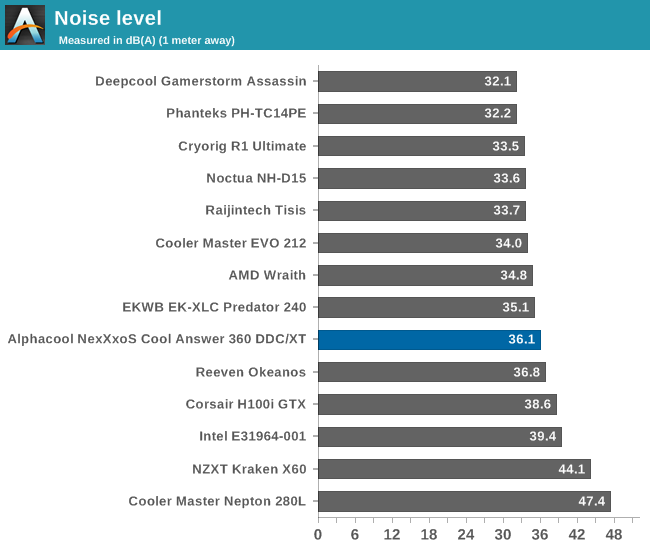
The NexXxoS Cool Answer 360 DDC/XT is the first “open loop” liquid cooler that we have reviewed here in AnandTech ever since March 2000. We took the opportunity in order to establish a rough performance baseline for all of our cooler reviews, showcasing how a custom liquid cooling setup can perform in comparison to air coolers and AIO liquid cooling solutions.
The NexXxoS Cool Answer 360 DDC/XT is a kit that has been designed to provide outstanding thermal performance while freeing the user from having to research the compatibility between individual parts. It comes with all of the necessary parts included, down to the last screw. Alphacool even includes a jump-start connector for the PSU, although any knowledgeable user can perform the same task with a simple wire. The Repack reservoir that is designed to be used with the Laing DDC-1T pump is very convenient and greatly enhances the overall tidiness of the system.
One might consider the NexXxoS Cool Answer 360 DDC/XT as a step towards custom liquid cooling loops but without the full risk and hassle associated with the selection of components. As we explored in this review, its installation is hardly more difficult than that of an AIO cooler. It is however wrong to believe that buying a full kit will ensure a trouble-free installation. The compatibility of the kit with the rest of the system needs to be diligently checked as well. Even when the case can theoretically support the liquid cooling parts, the user needs to consider whether other parts may interfere, like the heatsinks of the motherboard did in our case.
Expectedly, the thermal performance of the NexXxoS Cool Answer 360 DDC/XT significantly outpaces that of AIO liquid coolers. The whole kit is however tuned for maximum thermal performance and not for silent operation. By default, the pump cannot be controlled and the included fans are not optimal for very low speed operation. An expert can certainly modify the pump and program appropriate control profiles for both the pump and the fans, allowing the system to operate silently and efficiently, but that probably defeats the purpose of buying a pre-determined complete kit to begin with.
The retail price of 238€ plus shipping (about $ 260) at the time of this review is nearly twice as high as the price of a top-tier AIO cooler. Nevertheless, it is a reasonable price considering the quality of the included parts and their relative individual cost. A premium liquid cooling setup is expensive and similar kits can be found selling for well over $ 300. The extra performance and prestige associated with custom liquid cooling setups is disproportionately costly and falls up to the needs and wants of each individual user to decide whether they are a worthy investment.
Autore: AnandTech

